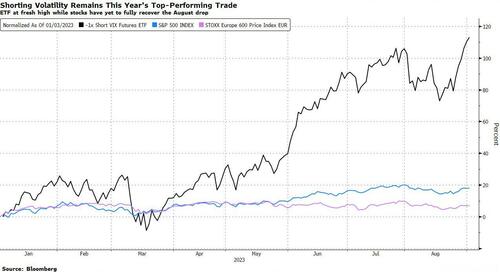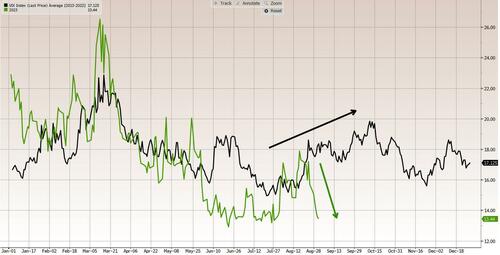Betting Against Fear Has Really Paid Off This Year
By Jan-Patrick Barnert, Bloomberg Markets Live reporter and strategist
A strategy of betting against equity market volatility has survived the summer doldrums with its status as a top-performing trade intact.
The August pullback in stocks in Europe and the US had pushed volatility readings higher, especially as investors braced for a burst of sentiment-testing central bank speeches in Jackson Hole. But while the VIX Index — Wall Street’s “fear” gauge — spiked to the highest since May, traders were quick to sell it again as the need to hedge against market risks quickly faded.
Those with strong stomachs would have enjoyed the wild ride on the way to further gains. An ETF tracking a short position in the VIX Index fell as much as 19% in the first half of August, a much deeper swoon than the 5%-6% drop in equities. However, the ETF finished the month up 2% and at a new high for this year, while major stock benchmarks are yet to recoup their August losses.
Volatility has made a striking break from its typical seasonal pattern. Instead of climbing as summer progresses, it is retreating toward the lowest levels for 2023. “The Volatility Index closed below 14 in August, suggesting stocks could rally in September, departing from the typically lackluster seasonal trends,” strategists at Sentiment Trader write.
The latest indications from systematical investors — who’ve been blamed for swings in the fear gauge in both directions — suggest that they are less likely to stir up volatility right now. “With the bulk of CTA equity unwinds likely behind us, market impact risk is reduced,” Bank of America strategists write.
And screening for market momentum has clearly turned over the past week toward an improving environment and away from a negative one, with the tech-heavy Nasdaq 100 Index in the lead. Meanwhile, other technical indicators are mixed, with Euro Stoxx 50 Futures hovering below their medium-term moving averages and not yet suggesting that a fresh test attempt to pierce the recent sideways pattern is imminent.
The rebound in stocks and fading volatility have gained support from central bankers signaling that interest-rate hikes are closer to the end than the beginning — while guarding against creating expectations of cuts anytime soon. And although much of what happens next depends on the data, the latest macro releases — including the Fed’s preferred measure of price pressures — have at least kept the mood brighter.
“After what proved to be a difficult August, a key measure of US inflation came in roughly in line with forecasts to help markets get September off to a steady start,” notes AJ Bell investment director Russ Mould.
There was more of the same on Friday, when US job market data showed that hiring picked up in August, while wage growth slowed. The figures aren’t anything to get over-excited about, but they underscore the notion of a gradually moderating labor market, while keeping concerns of a recession at bay.
Tyler Durden
Tue, 09/05/2023 – 08:25
via ZeroHedge News https://ift.tt/KkHAnFR Tyler Durden


